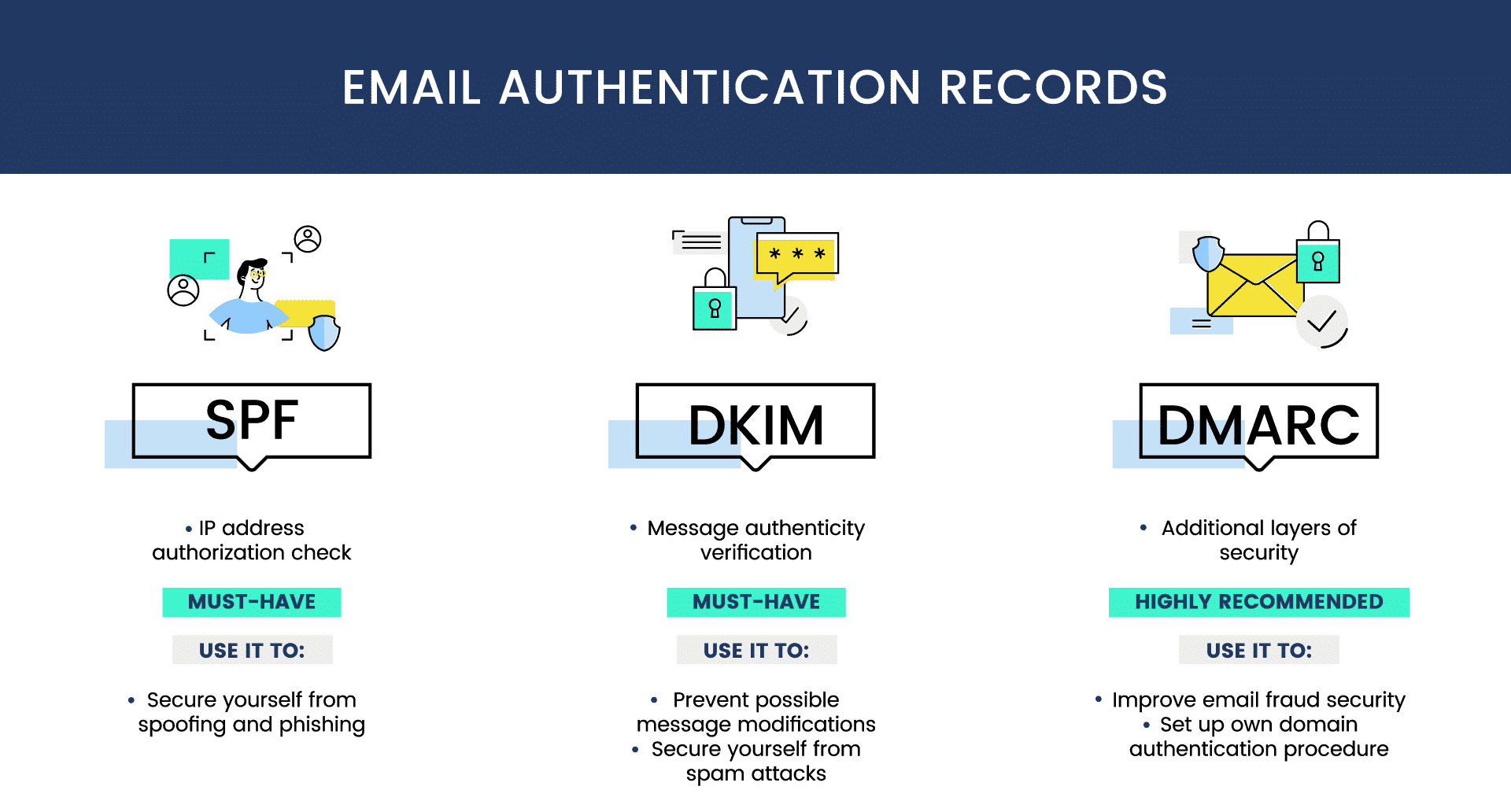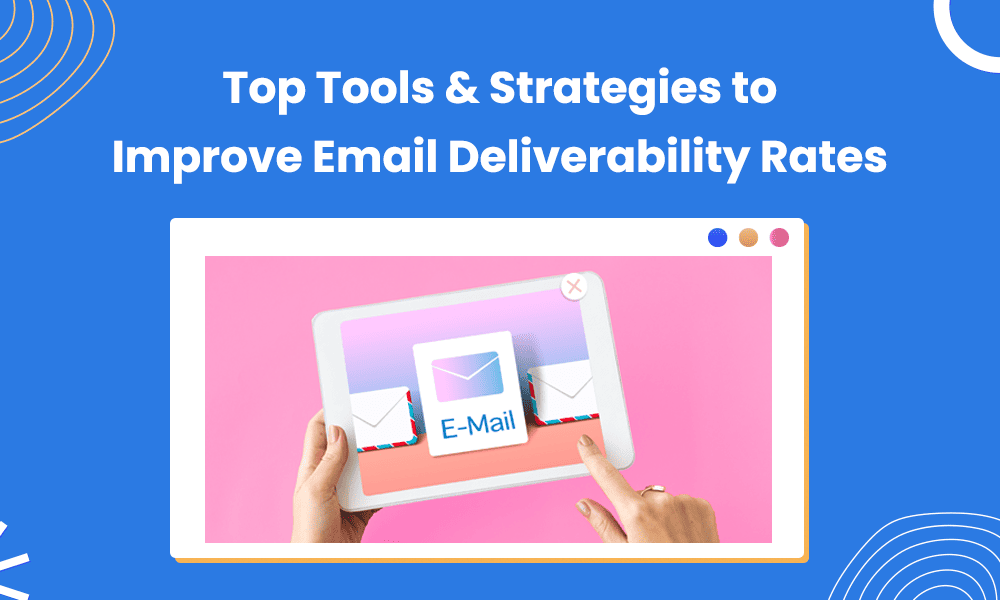Getting your messages to the primary inbox is much more than writing stellar emails and hitting the send button. This is because even when the emails get delivered, spam filters may drive them to other email folders your recipients cannot access easily.
Many businesses face this challenge despite their efforts to improve email deliverability rates – and it not only harms the brand reputation but ruins business growth, too.
This is why we’ve created this guide blog post. In this detailed article, we’ll show you what strategies and software tools can help you improve your email deliverability rates and how you can get started today.
Table of Contents
12 Strategies to Help You Improve Email Deliverability Rates
In this section, we go through essential strategies to land in the inbox every time, and in the next section, we’ll show you which tools can help implement these strategies.
1. Authenticate your email domain
Email authentication involves the preliminary steps to build the right email infrastructure and ensure security using defined protocols. It protects your emails and subscribers from spam and phishing attacks.
When cybercriminals use your emails for malicious purposes, affected users may get frustrated and mark your emails as spam. This sends negative signals to mailbox providers, causing them to reject or redirect your emails with spam filters.

Without proper email authentication protocols, you cannot prove your emails’ legitimacy, which can harm your deliverability. The three major authentication protocols include the following.
- Sender Policy Framework (SPF): This protocol allows receiving email servers to accept incoming emails from authorized senders.
- DomainKeys Identified Mail (DKIM): This protocol uses digital signatures in email headers to validate the integrity of a message.
- Domain-based Message Authentication Reporting and Conformance (DMARC): This protocol enables domain administrators to publish policies for handling incoming emails. It combines both SPF and DKIM protocols.
Smart implementation of these email authentication methods reduces your spam, prevents phishers from hijacking your emails, and protects your brand reputation.
2. Use a dedicated IP address
A shared IP address may be ideal for low-budget or new senders, and it’s easier to maintain a good domain reputation if other domains have good records. The downside, however, is you have less control, and the activities of other domain administrators can affect your sender reputation and domain performance.
This can cause email servers to blacklist your emails since you’re likely sharing the same IP address with spam senders.
On the other hand, a dedicated IP address, though expensive, gives you more control over your sender reputation and prevents receiving email servers from blacklisting your emails. Although not all email senders with shared IP addresses have malicious intentions, you have more flexibility and customizability over your email domain management when you use a secure address not affected by other senders’ activities.
👉 Elevate your email marketing with our free email templates designed to boost engagement and conversions.
Read also: How To Avoid Spam Filters For Better Email Deliverability
3. Keep your email list clean
Usually, your email list contains a variety of email addresses with real and fake users. And even among your true subscribers, some may no longer have interest in your brand over time, so sending emails to these groups may seem unnecessary.
Email list cleaning involves removing inactive or outdated contacts while keeping subscribers willing to continue with your brand. Sending emails to incorrect or invalid email addresses can lead to hard bounces. Moreover, users who have lost interest in your brand may move future emails from you to the junk folder since it no longer appeals to them.
So, cleaning your email list regularly ensures your emails are sent to the right recipients, thus reducing bounce rates and spam scores, and improving your deliverability. Here are a few tips to help you ensure a clean email list:
- Remove or merge duplicate email addresses
- Use simple opt-in forms with clear fields
- Delete spam email addresses
- Correct possible typos in the addresses
- Re-engage inactive users and remove those who no longer indicate interest in your brand
Enhance Your Email Marketing
Want to make your emails more impactful? Check out our beautiful, easy-to-customize recruitment and email templates. Designed to boost engagement, these templates from EngageBay will help your emails stand out. Just customize the images, headings, and CTAs for your brand, and hit send in a few minutes!
4. Write helpful and non-spammy content
Sending helpful, relevant, and engaging emails is one way to maintain high deliverability rates, as subscribers will receive emails that appeal to them. They can also move your emails from the junk folder to their primary inboxes, thus sending positive signals to mailbox providers.
So, even with a clean email list, capturing your existing customers’ attention with timely, relevant, and appropriate content is necessary.
Sometimes, spam filters can prevent your emails from getting to the inbox if they detect malicious patterns in your content. Therefore, you should always check your emails to remove spam trigger words or patterns that can cause these programs to flag your emails as spam.
Some tips for crafting helpful emails include the following:
- Avoid using too many exclamation points or special characters
- Correct grammatical or spelling errors
- Avoid using all-caps
- Create a balanced image-to-text ratio
- Do not use hard-to-read fonts or colors
- Avoid adding too many links
5. Use clear and engaging subject lines
Your email subject line is the first thing your recipients see before opening your email. It gives a concise overview of the email and compels your users to click and read through.
Poor subject lines can cause recipients to ignore or flag your emails as spam. According to stats from Gitnux, 69% of recipients report an email as spam based solely on the subject line.
So, if your subject line and preview text are not clear, compelling, and relevant, your recipients can move it to the spam folder, which can harm your deliverability rate.
6. Make unsubscribing easy
No matter how valuable your emails are, they may not always be the right fit for every user. Moreover, a segment of your audience may lose interest over time, and this is normal because as customers’ needs change, their desires and interests also change.
Moreover, your customers may not stay with you forever, so it’s important to create options that let them choose how to receive your emails. You can segment your customers based on how they prefer to receive your emails:
- Those who want to get all your brand updates
- Those who need only necessary updates
- Those who want to stop receiving updates from you
Adding an unsubscribe link or a preference center in your email – preferably in the footer – can help you filter out contacts whose priorities have changed, thus helping you create smart segments. When subscribers find it difficult to locate your unsubscribe link, they can move your emails to the spam folder out of frustration, so they don’t see future updates from you.
The unsubscribe option can also serve as a way to get customer feedback for improving your email marketing strategy. When inactive contacts can leave your brand easily, your emails will be less likely to be flagged as spam. This improves your sender reputation and, consequently, your deliverability rate.
7. Warm up your email account
Email warm-up is usually ideal for new or inactive email accounts, and it entails sending emails gradually and increasing your frequency until you get to your ideal sending volume.
Usually, recipients may not trust a new or dormant brand, so flooding your subscribers with too many emails can drive you to the junk folder.
Therefore, starting slowly – especially for cold email outreaches – is important until you have achieved a good sender score. You can pick a consistent sending schedule from here and stick to it. And since you’re using a new domain, it is advisable to have a consistent sender name to avoid confusing your recipients.
An improved sender score indicates your emails are from a legitimate source. As customers get familiar with your brand over time, your engagement rate will increase, thus increasing your sender reputation and, eventually, your deliverability rate.
👉 Boost your email marketing campaigns with EngageBay’s customizable email templates tailored for engagement and success.
8. Use a double opt-in subscription system
A double opt-in system involves sending a notice to new subscribers to confirm the validity of their email addresses before adding them to your contact database. It is a part of the strategies involved in cleaning your email list and ensuring only valid addresses are added.
This process prevents fake addresses that may increase your email bounce rates and hurt your sender’s reputation. Moreover, you have more qualified contacts who will engage with your emails and are less likely to flag you as spam.
9. Segment your email list
Email segmentation involves fragmenting your contact list into smaller groups based on pre-defined attributes or characteristics. Your customers have varying preferences, so putting them all in a single category and sending the same emails can make them lose interest in your brand, since most emails may be unwanted or unsolicited.
Proper email segmentation involves using certain attributes to craft personalized emails that appeal to different segments of your audience. Your email segments can be demographic, behavioral, geographic, or psychographic, depending on your business needs and customer preferences.
An excellent segmentation strategy can improve engagement rates and help you build healthier customer relationships. As customers interact with emails that appeal to them, mailbox providers perceive your emails as genuine and will prevent them from getting hit by spam filters.
10. Do not buy email lists
Having a large subscriber base is great. However, the quality of your contacts is more important than the quantity. In other words, 500 serious buyers are more important than 5,000 visitors who have no interest in your brand. Business owners who buy email lists bypass building qualified leads from the ground up, hoping to have a large contact list that will eventually increase sales.
While this may seem like a faster route, there are certain disadvantages with it:
- Your emails will be flagged as spam
- It can increase your unsubscribe rate
- Your email service provider may place restrictions on your domain
- You’re violating data protection laws
- It can reduce your sender’s reputation
- You end up sending emails to recipients who don’t trust you and won’t buy from you
These factors can create poor customer experiences, thus leading to low engagement rates and high spam scores. Eventually, your email address may get blacklisted since your emails are unwanted and don’t appeal to your contacts.
👉 Boost your marketing strategy with our customizable email templates that drive results.
11. Comply with anti-spam laws
Generally, antispam laws do not directly impact your email deliverability. However, they provide certain requirements and regulations that enable you to create helpful and appropriate email content. They also protect your subscribers from receiving unsolicited emails, thus helping you build healthy customer relationships.
The major requirements of the anti-spam laws include:
- Don’t use deceptive subject lines
- Include a valid physical address that shows your location
- Identify clearly that your message is an ad (if it is)
- Avoid using false or misleading header information
- Include a clear unsubscribe link to help users opt out of your emails easily
- Honor all opt-out requests promptly
12. Use a reliable email service provider (ESP)
An email service provider is usually a software application designed to help you craft and send emails at scale. It supports robust email marketing features that enable you to run successful campaigns. These features may include marketing automation, email verifier, list segmentation, reporting and analytics, and customizable email templates.
There are several ESPs with varying functionalities, but your choice largely depends on your business needs and size, so it’s important to pick tools with unique features to meet your brand goals and needs.
A poor email service provider can hurt your deliverability, as it may lack advanced features to help you deliver your emails to your subscribers’ inboxes. It may also lack important functionalities enabling you to segment and merge your lists to create personalized campaigns.
8 Tools To Improve Email Deliverability Rates
Email deliverability involves several complex processes and techniques. The good news is that many software tools are designed to streamline your workflow and empower your teams in this direction. Here are some of the best tools to improve email deliverability rates.
1. MailerLite – Email Marketing Software
MailerLite is a cloud-based email platform that combines digital marketing tools with advanced automated workflows to help you run successful email campaigns at scale. It supports basic features for promoting your eCommerce store, generating qualified leads, and managing your contacts.
The marketing solution also has an email verifier that enables you to optimize and clean your email list, ensuring only valid contacts are added to your customer database. An additional feature is the website builder that uses your brand style and tone to create simple pages for your business.
Although MailerLite has a free plan, the paid plan starts at $9/month for 500 subscribers.
👉 Optimize your marketing efforts with our email templates designed for efficiency and impact.
2. MxToolbox – Server Monitoring System
MxToolbox is a robust software that can be used for various internet operations like monitoring domain health, identifying and diagnosing issues in your IP or domain name system (DNS), monitoring blacklists, etc.
As a business owner, you can use MxToolbox to analyze your SPF record to check its valid syntax. This system supports advanced and sophisticated features for building the right email infrastructure.
There’s a free version available for users, though it has a few limitations. Business owners who need more advanced functionalities may start at $129/month.
3. NeverBounce – Email Verification Tool
NeverBounce is an email verification solution that helps businesses build clean email lists by verifying the validity of email addresses before adding them to their contact database. It does this by flagging duplicate, invalid, or spam email addresses.
Neverbounce is a simple email tool for improving the quality of your email list and reducing bounce rates. And while it has a free plan, you can get more at $8 for 1,000 emails with the paid plan.
4. InboxAlly – Email Deliverability Tool
InboxAlly is a powerful email deliverability tool that sends positive signals to mailbox providers to prevent them from rejecting your emails or flagging them as spam. It facilitates customer engagement with high open and click-through rates.
InboxAlly improves your deliverability rate by ensuring your emails reach the primary inbox. It also takes critical steps to remove your emails from the spam or promotions folder. Some features include email warm-up, campaign tracking, Broadcast Auto Detect, custom sending schedule, etc.
Starting at $149/month, you can access advanced features to prevent spam filter attacks.
5. Mailtrap – Email Testing Tool
Mailtrap is an email testing tool that inspects and analyses emails to check for possible errors or red flags that can harm your deliverability. It simulates receiving email servers to identify loopholes in your emails and helps you fix them before sending them to your recipients.
Mailtrap allows you to check your spam score, validate your headers, and preview your email design. It provides real-time data that shows the performance of your emails. You can use these insights to improve your email marketing strategy while adopting best practices to boost your deliverability rates.
Mailtrap has a free version. However, the paid plan starts at $14.99/month.
6. EngageBay – Email Marketing Software
EngageBay is an all-in-one customer relationship management software with an advanced marketing automation suite to help you run successful email campaigns. This email marketing platform supports robust features for capturing qualified leads, managing email lists, and automating your workflow.
With responsive and customizable email templates, EngageBay enables you to send attractive and personalized content at scale. This way, you can send high-quality emails that appeal to your customers.
Like other marketing automation platforms, EngageBay has a free version. However, the paid plan starts at $12.99/month for 500 contacts. Additionally, access a library of professionally designed, customizable email templates to streamline your marketing efforts and enhance engagement.
7. ActiveCampaign – Email Marketing Software
Like EngageBay, ActiveCampaign is a powerful email marketing and automation tool that helps you create newsletters, broadcast emails, and email autoresponders. Even though you’re non-tech savvy, it can help you craft beautiful emails with its drag-and-drop designer and prebuilt customizable templates.
ActiveCampaign improves email deliverability with spam check, domain verification, and campaign preview capabilities. It starts at $29/month.
8. Unspam.email – Email Deliverability Tool
Unspam.email is an email deliverability tool that offers several functionalities to ensure your emails reach the primary inbox. It is also an email testing tool with a preview feature and spam checker that lets you see how your emails look on different devices and possible patterns that may trigger spam filters.
The tool allows you to monitor your domain, email, and IP address to determine if you have been blacklisted. It also supports advanced capabilities for optimizing your SPF, SKIM, and DMARC records.
Unspam provides a free plan and other paid tiers starting at $9/month.
Final Takeaway
No matter how well-optimized your emails are, your recipients may never see them if you have deliverability issues.
While improving your open rates, click-throughs, and other email metrics is necessary, getting the messages to your subscribers first is also important. Otherwise, other factors won’t matter.
From authenticating your emails to improving security, pruning and segmenting your lists, and writing helpful content, you can improve your email deliverability and ensure your users receive your emails.
Since this involves complex processes, it will help to use email marketing tools that offer email authentication, marketing automation, email verification and segmentation, email testing, and other capabilities to prevent spam filters from hitting your emails.
Try EngageBay for free and see how it can help you.












